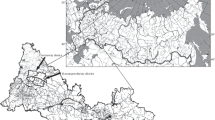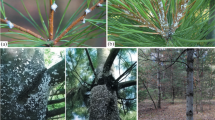Abstract
Naturalization of woody lianas poses a great danger to the ravine and floodplain forests of Rostov oblast. Therefore, the aim of the work was to study morphology, ecological and biological properties, and the invasive process of Partenocissus inserta. Studies were carried out in the Botanical Garden of the Southern Federal University and in the west of Rostov oblast in a floodplain oak forest at the confluence of the Mius and Krynka rivers. P. inserta penetrates into natural, seminatural, and disturbed communities and also is a part of the urban flora of Rostov-on-Don. In floodplain forests, it is a sub-edificator of the herbaceous layer, where it dominates and forms stable simple synusiae. This is the only representative of understory vegetation; it rises along the tree trunks to a height of 15–20 m, fixing itself in the unevenness of their bark by the twining tips of tendrils. It competes for the light with trees of the first story. This species changes the nature of the forest cenosis over a large area. The P. inserta naturalization strategy corresponds to the empty niche hypothesis.



Similar content being viewed by others
REFERENCES
Agafonov, V.A. and Kaz’mina, E.S., Features of the flora of anthropogenic isolates on the example of the Bayern Munich floristic complex in the Voronezh city, Vestn. Voronezh Gos. Univ., Ser.: Khim. Biol. Farm., 2013, no. 1, pp. 72–76.
Agafonov, V.A. and Tul’skii, A.V., Adventive fraction of forest zone flora in the Voronezh oblast, Vestn. Voronezh Gos. Univ., Ser.: Khim. Biol. Farm., 2018, no. 2, pp. 68–74.
Beans, C. and Roach, D., An invasive plant alters phenotypic selection on the vegetative growth of a native congener, Am. J. Bot., 2015, vol. 102, no. 2, pp. 217–224.
Belous’ko, Yu.L., Anthropogenic transformation of the forest flora of the recreational zone of the Orel city, Uch. Zap. Orel Gos. Univ., Ser.: Estest. Tekhn. Med. Nauki, 2012, no. 3, pp. 80–83.
Berezutskii, M.A. and Kharitonov, A.N., Studies of tree neophytes in the southern part of the Trans-Volga Uplands, Byul. Bot. Sada Sarat. Gos. Univ., 2016, vol. 14, no. 2, pp. 3–13.
Davis, M.A., Grime, J.P., and Thompson, K., Fluctuating resources in plant communities: a general theory of invisibility, J. Ecol., 2000, vol. 88, pp. 528–536.
Dronin, G.V., Alien plant species in the Syzranka River basin, Izv. Sarat. Univ., Nov. Ser.: Chem., Biol.,Ecol., 2017, vol. 17, no. 1, pp. 98–102.
Elton, C., The Ecology of Invasions by Animals and Plants, London: Methuen and Co., 1958.
Fike, J. and Niering, W.A., Four decades of old field vegetation development and the role of Celastrus orbiculatus in the Northeastern United States, J. Veg. Sci., 1999, vol. 10, no. 4, pp. 483–492.
Flora Nizhnego Dona (Flora of the Lower Don), Zozulina, G.M. and Fedyaeva, V.V., Eds., Rostov-on-Don: Rostov Gos. Univ., 1984–1985, parts 1–2.
Golovach, A.S., Liany, ikh biologiya i ispol’zovanie (Lians, Their Biology and Use), Leningrad: Nauka, 1973.
Grigor’evskaya, A.Ya., Lepeshkina, L.A., Vladimirov, D.R., and Sergeev, D.Yu., The creation of a black book for Voronezh oblast, Russ. J. Biol. Invasions, 2013, vol. 4, pp. 120–132.
Gusev, A.P., Alien species-transformers as the reason for blocking recovery processes (the south-east of Belarus), Ross. Zh. Prikl. Ekol., 2016, vol. 3, pp. 9–14.
Gusev, A.P., Landscape-ecological analysis of alien species-transformers distribution in natural and anthropogenic landscapes (the south-east of Belarus), Ross. Zh. Prikl. Ekol., 2017, vol. 2, no. 10, pp. 47–51.
Kazakov, M.V. and Buchkova, A.E., Tree invasive species in the flora of the Ryazan oblast, Mater. Vseross. nauchno-prakt. konf. “Geograficheskie i geoekologicheskie issledovaniya v reshenii regional’nykh problem” (Proc. All-Russia Sci. Pract. Conf. “Geographical and Geo-Environmental Research in Solving Regional Problems”), Ryazan: Ryazan. Gos. Univ., 2017, pp. 119–121.
Kozlovskiy, B.L., Kuropyatnikov, M.V., and Fedorinova, O.I., Ecological and biological characteristics of tree plants of Rostov-on-Don urban flora, Izv. Irkutsk Gos. Univ.,Ser. Biol., 2011, vol. 4, no. 2, pp. 38–43.
Kozlovskiy, B.L., Ogorodnikov, A.Ya., Ogorodnikova, T.K., Kuropyatnikov, M.V., and Fedorinova, O.I., Tsvetkovye drevesnye rasteniya Botanicheskogo sada Rostovskogo universiteta (ekologiya, biologiya, geografiya) (Floral Woody Plants of the Botanical Garden of Rostov University (Ecology, Biology, and Geography)), Rostov-on-Don: Starye Russkie, 2000.
Kozlovskiy, B.L., Kuropyatnikov, M.V., Fedorinova, O.I., Sereda, M.M., Kapralova, O.A., Dmitriev, P.A., and Varduni, T.V., Adventive tree species in urban flora of Rostov-on-Don, Biol. Bull. Bogdan Chmelnitskiy Melitopol State Pedagog. Univ., 2016, vol. 6, no. 3, pp. 430–437. http://ojs.mdpu.org.ua/index.php/biol/article/ view/114/1721). Accessed January 10, 2019.
Kupchinov, V.M., Assortment for street and parks plantations of Rostov-on-Don city, in Collected Works of Rostov-on-Don Komintern Botanical Garden for 1934, Rostov-on-Don: Bureau Khozbulletins, 1934, pp. 3–44.
Litvinskaya, S.A. and Savchenko, M.Yu., On the issue of invasiveness of the Western Caucasus flora, Bot. Vestn. Sev. Kavk., 2016, no. 1, pp. 23–35.
Lyubchenko, V.M. and Bortnyak, N.N., Mass invasion of some North American trees and shrubs into phytocenoses of the Middle Dnieper region (Ukrainian SSR), in Problemy izucheniya adventivnoi flory SSSR (Problems of Studying the Adventive Flora of the USSR), Moscow, 1989, pp. 61–63.
Nikolaeva, M.G., Razumova, M.V., and Gladkova, V.A., Spravochnik po prorashchivaniyu pokoyashchikhsya semyan (Handbook on Germination of Dormant Seeds), Leningrad: Nauka, 1985.
Ogorodnikov, A.Ya., Methodology of visual assessment of bioecological parameters of woody plants in populated areas of steppe zone, in Itogi introduktsii rastenii (Summaries of Plant Introduction), Rostov-on-Don: Rost. Gos. Univ., 1993, pp. 50–58.
Rehder, A., Manual of Cultivated Trees and Shrubs Hardy in North America, New York: Macmillan Co., 1949.
Saksonov, S.V., Rakov, N.S., Vasyukov, V.M., and Senator, S.A., Alien plants in forest communities of the Middle Volga region: methods of dissemination and degree of naturalization, Samara Nauch. Vestn., 2017, vol. 6, no. 2 (19), pp. 78–83.
The William and Lynda Steere Herbarium. http://sweetgum.nybg.org/science/vh/specimen_list.php. Accessed January 28, 2019.
Tomson, K. and Grime, J.P., Seasonal variation in the seed banks of herbaceous species in ten contrasting habitats, J. Ecol., 1979, vol. 67, no. 3, pp. 893–921.
Vasyukov, V.M. and Novikova, L.A., Naturalized alien plants of Penza oblast, Samara Nauch. Vestn., 2017, vol. 6, no. 1 (18), pp. 19–22.
Voss, E.G., Michigan Flora: A Guide to the Identification and Occurrence of the Native and Naturalized Seed-Plants of the State, Part II: Dicots (Saurupaceae–Cornaceae), Cranbrook Inst. Sci., 1985, no. 59.
Weeda, E., Invasions of vascular plants and mosses in to the Nederland’s, Proc. Kon. Ned. Akad. Wetensch., 1987, vol. 90, no. 1, pp. 19–29.
Yurkonis, K.A. and Meiners, S.J., Invasion impacts local species turnover in a successional system, Ecol. Lett., 2004, pp. 764–769.
Zaitsev, G.N., Fenologiya drevesnykh rastenii (Phenology of Woody Plants), Moscow: Nauka, 1981.
Funding
This study was supported by the Ministry of Education and Science of the Russian Federation (project no. 6.6222.2017/8.9).
Author information
Authors and Affiliations
Corresponding author
Ethics declarations
COMPLIANCE WITH ETHICAL STANDARDS
The article does not contain any studies involving animals in experiments performed by any of the authors.
CONFLICTS OF INTEREST
The authors declare that they have no conflicts of interest.
Additional information
Translated by T. Kuznetsova
Rights and permissions
About this article
Cite this article
Kozlovskiy, B.L., Fedorinova, O.I. & Kuropyatnikov, M.V. Invasion of the Parthenocissus inserta (Kern.) K. Fritsch. in Floodplain Forests of Rostov Oblast. Russ J Biol Invasions 11, 41–46 (2020). https://doi.org/10.1134/S2075111720010075
Received:
Revised:
Accepted:
Published:
Issue Date:
DOI: https://doi.org/10.1134/S2075111720010075




